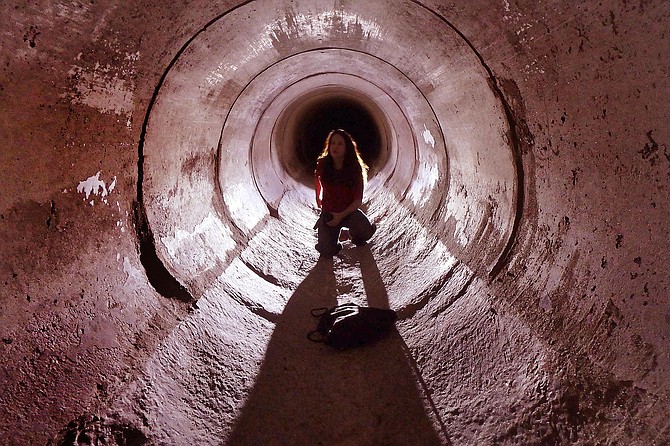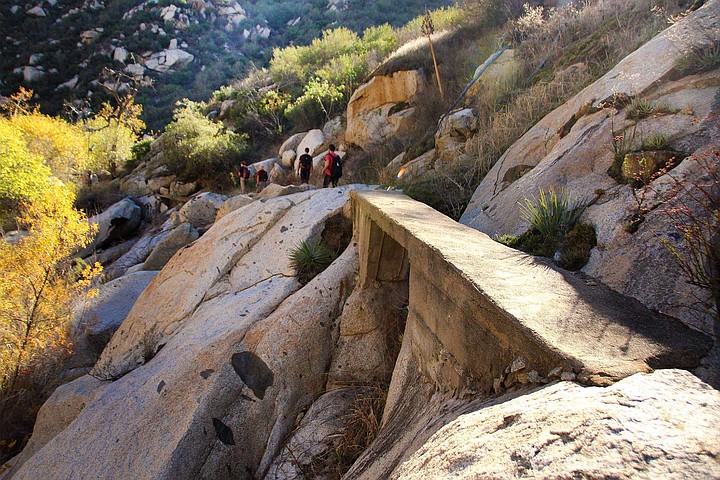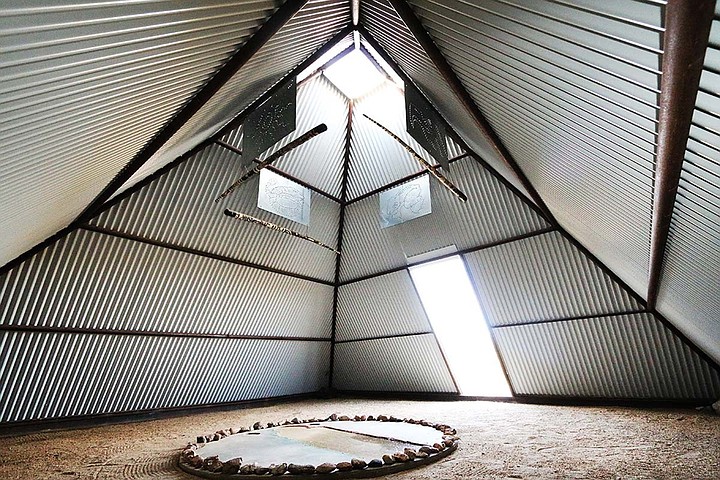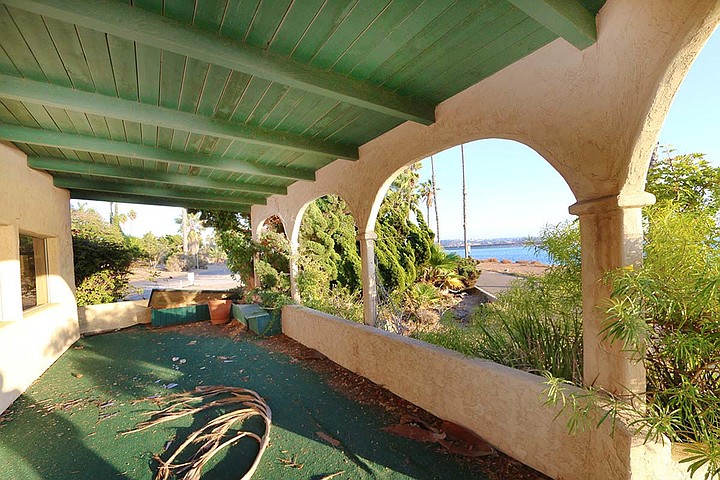 Facebook
Facebook
 X
X
 Instagram
Instagram
 TikTok
TikTok
 Youtube
Youtube

Jessica Johnson has been on many outings during which she has thought to herself, “We might die today.” Like the time she and some companions were six miles deep into the back country near the El Capitan reservoir, photographing the flume and making their way towards the dam — the end point of their hike. When they paused for a break, one of her friends started climbing a rock wall and happened to disturb a hive of bees. “Suddenly,” she says, “we had thousands of bees chasing after us.”

Johnson thought fast: “I’d had a situation when I was kid where this exact same thing happened, and I got low to the ground and pretended I was a rock, and all my friends got stung a ton of times and I got stung zero times. So I’m telling my friends this story. I’m like, ‘You guys— meditate, completely ignore them, and just walk as fast as you can away from the bees.’ We literally had bees hitting us in the head.” She demonstrates for me, making her finger into an aggravated bee that repeatedly bonks the side of her face. “But none of them stung us, because we stayed calm and completely ignored them.”
Johnson says that she has many such stories, but one jumps out at her from the dark closet of memory. She and two companions headed out to Jacumba several years ago to take a look at some abandoned trains. Along the way, they found some other intriguing desert things: a curious lone pyramid in the distance and, much closer, four cement tubs, empty but made for bathing in the hot spring water found in the area. Next to the tubs, she found a woman’s purse that gave her an eerie feeling. Had the owner been abducted? Had some other misfortune happened? Despite — or perhaps because of — that eerie feeling, Johnson felt that the purse gave her party a good excuse to go further into this property — specifically, over to the pyramid, to see if people were about. She reasoned that if they encountered someone on this piece of what was probably private land — “It’s not always easy to tell,” she notes — she could say that she was trying to return the purse to its owner. She and her friends made their way over.

Recalls Johnson, “So we go to the pyramid, and sure enough, you can hear people talking in there. I knock on the pyramid, and you can hear them all get quiet.”
“Hi, I’m Jessica,” she said to the door. “We found this purse. I’m wondering if someone lost it?” There was a pause.
“Finally, this man talks. But whenever the man asks us a question, immediately after, a woman echoes what he says.”
Man: “Hello.”
Woman: “Hello”
Man: “How many of you are there?”
Woman: “How many of you are there?”
Johnson answered that there were three of them. They were then asked a couple of other questions before the pyramid dwellers asked if they would like to come inside. The door opened to reveal — relievingly, I assume — a group of four old hippie types, one of whom was indeed the owner of the purse. The structure was empty inside, expect for a cement slab in the center. There were silhouettes of three bodies outlined on the slab — less relieving, I assume.
“If you would have been here ten minutes earlier or ten minutes later,” said one of the hippies, “you would have been at the wrong time. But you guys came at the right time.” For what, exactly? It was unclear. The hippie said that before he had them lay down, he wanted to know if any of them had claustrophobia, or any issue with being locked in the pyramid.
“My friend says, ‘Yes, me,’” recalls Johnson, “and he says, ‘Good — you’ll lay in the middle.’ Boom! He slams the pyramid door shut.”

As she laid herself down, Johnson thought, “We really got ourselves into a situation.” On the other hand, she feels she can read people well, and says she didn’t feel any “dark energy” from the pyramid people.
Johnson’s not exactly sure of the meaning of what the old hippies got up to next, but they began to make various motions and sounds over their supine guests on the slab: waving fingers, shaking bottles around their faces and in their ears. She says she found it surprisingly amusing, and had to stifle her laughter by biting her cheek. Happily, it all ended well: “Yeah, Now I’m friends with all of them. They’ve turned the area into an Airbnb.”
The effort and the hazards of days like that one in the desert are all labors of love on behalf of Johnson’s project, Hidden San Diego, a digital compendium of destinations and curiosities that might escape the average San Diegan’s notice. She started work on it in 2010. “I don’t think I would have created the concept now,” Johnson tells me. The explosive growth of social media and the limitless quantity of content developed since then would have made her reluctant to try. But Hidden San Diego has survived, remaining relevant by broadening its range of material, joining the social media fray, and continuously growing its array of local hidden treasures.
In 2019, her first book, Abandoned San Diego, was published, and she received a Town Crier award from San Diego’s Save Our Heritage Organization for her work documenting and writing “enticingly about irreplaceable, little known, majestic, or designated historic sites and buildings.” Today, she’s still out and about, even with a new baby and a day job. Recently, she made her way over to photograph the current state of the De Anza Trailer Park on Mission Bay, where residents in a hurry to leave have left their homes and belongings behind. It’s a piece of newly abandoned San Diego that will soon exist only in memories, stories, and photographs — thanks in part to Johnson’s curiosity and curation.


Jessica Johnson has been on many outings during which she has thought to herself, “We might die today.” Like the time she and some companions were six miles deep into the back country near the El Capitan reservoir, photographing the flume and making their way towards the dam — the end point of their hike. When they paused for a break, one of her friends started climbing a rock wall and happened to disturb a hive of bees. “Suddenly,” she says, “we had thousands of bees chasing after us.”

Johnson thought fast: “I’d had a situation when I was kid where this exact same thing happened, and I got low to the ground and pretended I was a rock, and all my friends got stung a ton of times and I got stung zero times. So I’m telling my friends this story. I’m like, ‘You guys— meditate, completely ignore them, and just walk as fast as you can away from the bees.’ We literally had bees hitting us in the head.” She demonstrates for me, making her finger into an aggravated bee that repeatedly bonks the side of her face. “But none of them stung us, because we stayed calm and completely ignored them.”
Johnson says that she has many such stories, but one jumps out at her from the dark closet of memory. She and two companions headed out to Jacumba several years ago to take a look at some abandoned trains. Along the way, they found some other intriguing desert things: a curious lone pyramid in the distance and, much closer, four cement tubs, empty but made for bathing in the hot spring water found in the area. Next to the tubs, she found a woman’s purse that gave her an eerie feeling. Had the owner been abducted? Had some other misfortune happened? Despite — or perhaps because of — that eerie feeling, Johnson felt that the purse gave her party a good excuse to go further into this property — specifically, over to the pyramid, to see if people were about. She reasoned that if they encountered someone on this piece of what was probably private land — “It’s not always easy to tell,” she notes — she could say that she was trying to return the purse to its owner. She and her friends made their way over.

Recalls Johnson, “So we go to the pyramid, and sure enough, you can hear people talking in there. I knock on the pyramid, and you can hear them all get quiet.”
“Hi, I’m Jessica,” she said to the door. “We found this purse. I’m wondering if someone lost it?” There was a pause.
“Finally, this man talks. But whenever the man asks us a question, immediately after, a woman echoes what he says.”
Man: “Hello.”
Woman: “Hello”
Man: “How many of you are there?”
Woman: “How many of you are there?”
Johnson answered that there were three of them. They were then asked a couple of other questions before the pyramid dwellers asked if they would like to come inside. The door opened to reveal — relievingly, I assume — a group of four old hippie types, one of whom was indeed the owner of the purse. The structure was empty inside, expect for a cement slab in the center. There were silhouettes of three bodies outlined on the slab — less relieving, I assume.
“If you would have been here ten minutes earlier or ten minutes later,” said one of the hippies, “you would have been at the wrong time. But you guys came at the right time.” For what, exactly? It was unclear. The hippie said that before he had them lay down, he wanted to know if any of them had claustrophobia, or any issue with being locked in the pyramid.
“My friend says, ‘Yes, me,’” recalls Johnson, “and he says, ‘Good — you’ll lay in the middle.’ Boom! He slams the pyramid door shut.”

As she laid herself down, Johnson thought, “We really got ourselves into a situation.” On the other hand, she feels she can read people well, and says she didn’t feel any “dark energy” from the pyramid people.
Johnson’s not exactly sure of the meaning of what the old hippies got up to next, but they began to make various motions and sounds over their supine guests on the slab: waving fingers, shaking bottles around their faces and in their ears. She says she found it surprisingly amusing, and had to stifle her laughter by biting her cheek. Happily, it all ended well: “Yeah, Now I’m friends with all of them. They’ve turned the area into an Airbnb.”
The effort and the hazards of days like that one in the desert are all labors of love on behalf of Johnson’s project, Hidden San Diego, a digital compendium of destinations and curiosities that might escape the average San Diegan’s notice. She started work on it in 2010. “I don’t think I would have created the concept now,” Johnson tells me. The explosive growth of social media and the limitless quantity of content developed since then would have made her reluctant to try. But Hidden San Diego has survived, remaining relevant by broadening its range of material, joining the social media fray, and continuously growing its array of local hidden treasures.
In 2019, her first book, Abandoned San Diego, was published, and she received a Town Crier award from San Diego’s Save Our Heritage Organization for her work documenting and writing “enticingly about irreplaceable, little known, majestic, or designated historic sites and buildings.” Today, she’s still out and about, even with a new baby and a day job. Recently, she made her way over to photograph the current state of the De Anza Trailer Park on Mission Bay, where residents in a hurry to leave have left their homes and belongings behind. It’s a piece of newly abandoned San Diego that will soon exist only in memories, stories, and photographs — thanks in part to Johnson’s curiosity and curation.
Comments